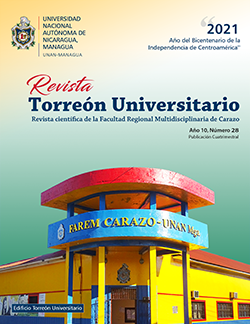Structure of the diatom communities of the sediments of Lake Cocibolca and its relationship with the natural and anthropogenic events
DOI:
https://doi.org/10.5377/rtu.v10i28.11531Keywords:
Cocibolca Lake, diatoms, index, diversity, sedimentAbstract
In order to identify diatoms and thier behavior in a sediment profile and thier relation topl natural and anthropogenic events, sediment sampling was carried out in Cocibolca Lake. A total of 46 taxa were identified with the highest diversity at the PLN I site (41 taxa) and the least at the PLN II site (24 taxa). The most representative genus in the PLN I were: Aulacoseira (12.20%), Fragilaria (7%), Navicula (12.20%), Nitzschia (7.32%), Pseudostaurosira (12.20%), and Surirella (9.76%). At the PLN II site they were: Aulacoseira (20.83%), Nitzschia (12.50%), Pseudostaurosira (12.50%), Surirella (8.33%), Cyclotella (8.33%) and Synedra (8 , 33%). Within the genus Aulacoseira the species A. muzzanensis showed to be the most dominant (44%; PLN I) and (64.58% PLN II).
Of the species found, four of them (Aulacoseira ambigua, A. subartica, Discotella stelligera and Stephanodiscus) show significant oscillations such as the replacement of one species by another that depends on environmental changes in the aquatic environment. The PLN I site shows more evidence of the changes that the body of water had at some time, which is reflected in the dominance of one species when another disappears. Presumably, for a time the conditions of the lake varied, being better observed at this site.
The application of the Shannon and Simpson indices show that the PLN I site is where the highest calculated values are observed (1,081 and 2,412 bit) respectively
Downloads
Downloads
Published
How to Cite
Issue
Section
License
Los autores que publican en esta revista están de acuerdo con los siguientes términos.
- El autor o los autores de los artículos, ensayos o investigaciones conceden a la Universidad Nacional Autónoma de Nicaragua, Managua (UNAN-Managua) los derechos de edición (copyright) del trabajo enviado, por consiguiente la Universidad cuenta con el derecho exclusivo para publicar el artículo durante el periodo completo de los derechos de autor.
- Estos derechos de autor/ autores autorizan a la Revista Torreón Universitario y a la Universidad editar y divulgar/publicar el artículo en dicha Revista, incluyendo reproducción impresa y electrónica, el almacenamiento, recuperación y cualquier otro tipo de publicación, y fuentes de información secundaria como servicios de resúmenes y bases de datos, así mismo la facultan a proteger el artículo contra el uso no autorizado para su difusión por medios impresos o electrónicos (PDF, HTML, EPUB, XML u otros).
Licencia para el uso del contenido
La revista hace uso de la Licencia Creative Commons Atribución-NoComercial-SinDerivar 4.0 Internacional.
Bajo esta declaración:

Este revista está sujeta a una licencia de Creative Commons Reconocimiento-NoComercial-SinObraDerivada 4.0 Internacional. Puede ser copiada, distribuida y transmitida públicamente siempre y cuando se cite al autor y la fuente (Revista Torreón Universitario), no debe modificarse ni utilizarse con ningún fin comercial. La licencia completa se puede consultar en http://creativecommons.org/licenses/by-nc-nd/4.0/.

